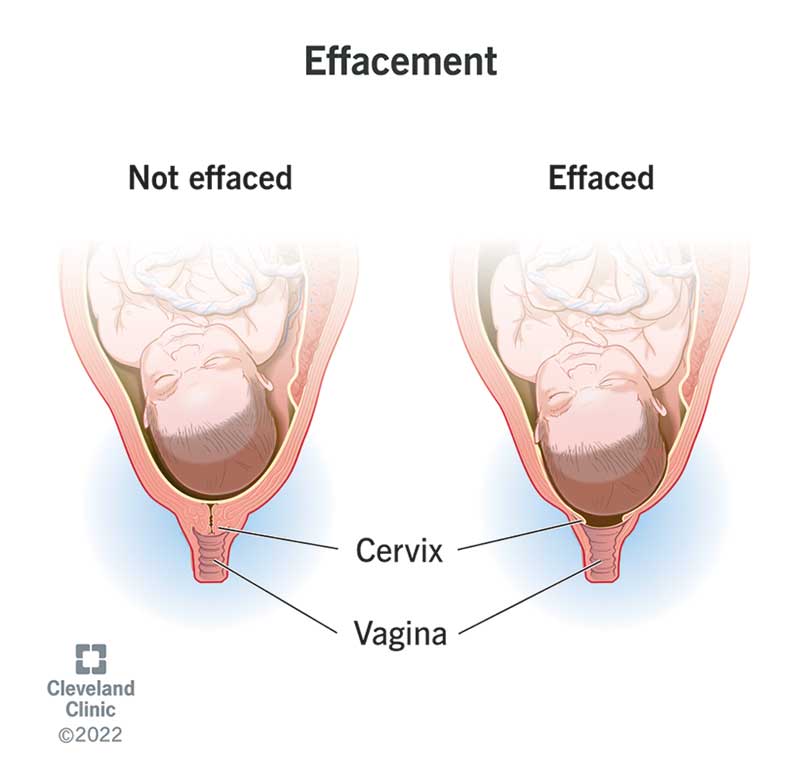Effacement is the thinning and shortening of your cervix. It happens at the end of pregnancy in preparation for childbirth. Your cervix must be 100% effaced for a vaginal delivery.
Advertisement
Cleveland Clinic is a non-profit academic medical center. Advertising on our site helps support our mission. We do not endorse non-Cleveland Clinic products or services. Policy

Cervical effacement (or ripening) is when your cervix softens, thins and shortens. It’s a natural part of pregnancy that happens as your body prepares for delivery. Your cervix will eventually thin out (efface) and open (dilate) enough for your baby to pass through your vagina.
Advertisement
Cleveland Clinic is a non-profit academic medical center. Advertising on our site helps support our mission. We do not endorse non-Cleveland Clinic products or services. Policy
Your healthcare provider may check your cervix with gloved fingers to measure effacement once you’re full-term. This is around 39 weeks in pregnancy. They’ll also measure it while you’re in labor to check your progress.
To understand how effacement works, it helps to know your cervix’s role during pregnancy.
Your cervix is long, firm and closed during pregnancy. This is to keep the fetus in your uterus and keep germs out of it. Your cervix is 3 to 4 centimeters (cm) long during pregnancy. You can think of it like a cork in a bottleneck.
As you get closer to delivery, the fetus drops down into your pelvis. If the fetus is head-down, its head presses against your cervix. This pressure can trigger effacement. During labor, uterine contractions push your baby downward, causing more pressure. It causes your cervix to go from hard and long to soft and short.
Over time, your cervix gets drawn up toward your uterus. Once your cervix is fully effaced, it’s as thin as a piece of paper. It no longer acts like a cork in a bottleneck.
Healthcare providers measure effacement in percentages. So, 0% effaced means your cervix is still long and firm. When your cervix has completely thinned, it’s 100% effaced. This means your cervix can’t thin or shorten any farther. Before you start to push in a vaginal delivery, your cervix must be 100% effaced.
Advertisement
As another example, an effacement of 80% means you’re only 20% away from being completely effaced. In other words, you’re 80% done with the effacement process.
Like most things related to pregnancy and labor, there’s no way to know how long effacement will take. Once effacement starts, it means you’re close to labor — or in it. But no one can know exactly how close or how long it’ll take before you’re ready to push.
Each pregnancy and cervix is different. For example, some women are 2 cm dilated and 30% effaced for weeks. Others remain 0% effaced and 0 cm dilated until a few days before delivery.
Dilation is when your cervix opens. Healthcare providers measure it in centimeters. If your cervix is completely closed, it’s 0 cm dilated. It’s fully dilated at 10 cm wide. Effacement affects your entire cervix. Dilation affects the external os — the part of your cervix that opens into your vagina.
Cervical dilation and effacement go hand in hand. Like effacement, dilation also happens because of uterine contractions. Your cervix must be 100% effaced and 10 cm dilated before the pushing stage of a vaginal delivery can begin.
Yes, you can be effaced but not dilated. If this is your first delivery, chances are, your cervix will efface before it dilates. Your cervix can also be dilated and not effaced. This is more common in second or third pregnancies. In some cases, your cervix will efface and dilate at the same rate.
You can’t feel your cervix effacing. You may suspect your cervix is changing because you have other labor symptoms. Some of the signs of cervical effacement may include:
All these symptoms are signs that labor is near. Only your healthcare provider can tell you if effacement has started. Trying to check yourself can be hard when you don’t have training to do cervical checks.
In some cases, effacement can be too slow. Some reasons for slow effacement include:
Your healthcare provider may recommend position changes, medications or other interventions to help.
Sometimes, your cervix can efface too soon in pregnancy. This can cause you to go into labor early — before 37 weeks. Some reasons for early effacement include:
Your healthcare provider will monitor your pregnancy for any issues. This is why it’s important to go to all of your prenatal appointments. Let your provider know as soon as possible if you have concerning symptoms.
Advertisement
Braxton Hicks contractions won’t make your cervix change or efface. Braxton Hicks are practice contractions. They’re your body’s way of preparing for real contractions. Real labor contractions cause your cervix to efface and dilate.
There are a lot of new terms to learn when it comes to pregnancy. “Effacement” is one of them. While dilation often gets all the attention, effacement is just as important. You need the completion of both to have a vaginal delivery. Your healthcare team will keep you updated on your cervical changes toward the end of your pregnancy and during labor. Don’t hesitate to ask questions.
Advertisement
From routine pelvic exams to high-risk pregnancies, Cleveland Clinic’s Ob/Gyns are here for you at any point in life.

Last reviewed on 08/08/2025.
Learn more about the Health Library and our editorial process.